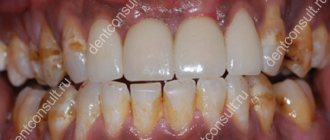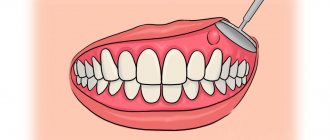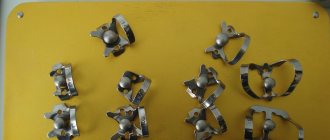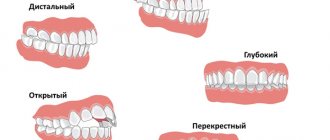About 20% of people on the planet face such a problem as gaps between teeth. Dentists call the gaps between the central teeth diastema, and between any other teeth - trema. Aesthetic dentistry can offer a way to get rid of this problem - and more than one.
Trema is not only a cosmetic defect that significantly reduces the patient’s quality of life, but a dangerous pathology that can lead to the development of serious dental diseases: trema negatively affects the stability of the teeth, exposing them to additional stress - this, in turn, leads to the appearance of caries, various gum diseases.
Diastema and trema - what is it and how do these pathologies differ?
Dental diastema is the visible gap between the front teeth of the upper or lower row. The size of the gap can range from 1 mm to 1 cm. This is not only an aesthetic drawback, it causes speech impairment and serious discomfort while eating. Diastema is often a consequence of abnormal development of the labial frenulum.
Trema is one or more spaces between teeth in the entire dentition. It often occurs when baby teeth erupt, or if their size is too small.
Despite the fact that trema and diastema are characterized by the presence of gaps in the dentition, there is a significant difference between them. Diastema forms only between the front teeth, and trema can form between any dental units.
It is important to know. Orthodontic correction should be started as soon as possible, since the presence of gaps in the dentition significantly increases the risk of developing diseases of the teeth and gums.
Do you feel like your teeth are uneven?
Read more detailed information about the causes of malocclusion in the interesting material of an orthodontist, Ph.D. Gevorkyan T.V. " Eight Causes of Crooked Teeth in Adults
"
In conclusion, what is the best way to straighten your teeth?
As you know, there are several methods, but the main ones are braces, aligners and veneers. In the first two cases, we are really talking about correcting the bite, and veneers are, say, only cosmetic work. But the question still remains - WHAT to choose, what braces to put on? Or stick with aligners?
comparative analysis may come in handy
these methods of treating malocclusion. More than 70 parameters (!), but the material is very easy to read. And we hope it will help you make your choice.
For children
— the main methods of correcting malocclusion are plates, myofunctional trainers, functional devices and “2x4 braces.” You can read about the pros and cons of these methods HERE.
Types of diastemas
- False diastema - occurs during the eruption of baby teeth, does not require orthodontic intervention and disappears on its own when permanent teeth erupt.
- True diastema - occurs in adolescence with the complete replacement of primary teeth with permanent ones (provided that there are no other defects in the dentition).
- Physiological trema – caused by the growth of the jaw bones.
- Pathological trema - diagnosed in patients with permanent teeth, occurs as a result of gum disease and bone atrophy.
It is important to know. Many people with diastema experience difficulty communicating, which negatively affects their personal life and career.
Classification of diastemas:
- parallel – the size of the gap between the teeth does not exceed 4 mm;
- triangular – has the shape of a triangle with the apex near the frenulum, characterized by large dimensions (more than 4 mm);
- triangular with an apex at the border of the crowns - occurs when extra teeth form between the two medial incisors.
There are also symmetrical (central) and asymmetrical diastema. The central diastema is characterized by the divergence of teeth in different directions by the same distance. And with an asymmetrical form of pathology, one dental unit deviates to the side, while the other remains in place.
How to remove gaps between teeth?
Modern dentistry offers the following options:
- Veneers. They are dental onlays attached to the front surface of the patient's teeth. Their main purpose is to correct the aesthetics of the dentition without the need for orthodontic treatment. Veneers are made in Moscow strictly individually in a dental laboratory. At the first stage, the patient’s tooth is ground down (a thin layer of enamel is removed), and an impression is made of it, which serves as a sample for creating a veneer. Making a veneer takes from 7 to 14 days, during which time the patient wears temporary veneer structures. After the permanent veneers are made, fitting is carried out, their compliance with aesthetic standards and the wishes of the patient is checked, if everything is good, the specialist fixes the veneer. The advantages of this option include the ability to correct even wide gaps between teeth in the shortest possible time.
- Bracket systems. The safest, high-quality method, loyal to dental tissues, but also the longest. To correct the bite, braces are used. If the patient is a child whose baby teeth have only recently been replaced by permanent teeth, braces are the best option. Modern braces are almost invisible, so they do not cause discomfort in everyday life. In addition, you can always order lingual braces, which are attached to the inside of the dentition, which means they are absolutely invisible. The time for wearing braces is determined by the dentist individually in each case - the timing depends on the structure of the teeth, the age of the patient, the size of the gap and other factors. Usually we are talking about a time range from six months to two years.
- Artistic composite restoration. This is the most preferred method when it comes to eliminating gaps between fangs, incisors, and slight curvature. Composites are photopolymer elastic materials that are applied layer by layer and harden under a photopolymerizer (special lamp). The advantages of artistic dental restoration include the speed of achieving results (restoration takes up to half an hour to two hours), the absence of painful sensations for the patient, and the absence of the need to grind down tooth enamel.
The above are not all the ways to get rid of gaps between teeth. Perhaps your dentist, having assessed the condition of your oral cavity, will offer you a more effective and/or profitable alternative - this could be a plastic transparent mouthguard (easily removed, allowing you to combine the adjustment of the position of your teeth with their whitening), corrective fillings or crowns.
Diastema treatment methods
- Therapeutic method. Suitable only for eliminating small clefts. The essence of the method is the cosmetic restoration of the defect using composite veneers.
- Orthopedic method. Treatment consists of installing ceramic veneers or crowns. This is a fairly effective method that allows you to eliminate diastema for a long period of time.
- Surgical method. It is used if a gap has appeared between the teeth as a result of incorrect positioning of the frenulum of the upper or lower lip. The method is most effective for young patients.
- Orthodontic method. To eliminate the defect, specialized braces, orthodontic aligners, and corrective plates are used. A significant advantage of this method is that the installation of leveling systems does not require grinding or grinding of teeth.
It is important to know. If a diastema is detected on baby teeth, no measures need to be taken to eliminate it! It is necessary to wait until the molars erupt.
Curing diastema with aligners is as easy as shelling pears!
Treatment of diastema with aligners is the most comfortable for you and invisible to others.
The result of treatment is always 100% Star Smile orthodontists work in more than 70 cities of Russia, and we can offer you a competent, detailed consultation in your city - absolutely free for you!
Would you like a free consultation on diastema? After treatment with aligners, you will forever forget about this gap between your teeth, which now causes you discomfort.
Is it necessary to correct the diastema and what will happen if nothing is done?
The occurrence of this problem will require a mandatory consultation with a dentist. The doctor will examine the oral cavity and order an x-ray, and then select treatment to eliminate the diastema.
If the patient does not listen to the dentist’s recommendation and ignores the existing problem, he risks facing serious consequences:
- diseases of the dentofacial apparatus;
- problems with speech (lisp, whistling);
- periodontal diseases;
- tooth loss.
Diastema: Closing gaps between teeth using braces, veneers and other options
If a patient has a diastema, it is important to answer several questions: is the defect cosmetic or functional? What causes tooth discrepancy? What procedures are needed to fill the gap? These questions can be answered only after diagnosis, which includes taking a panoramic image of the jaw or computed tomography, examination by an experienced specialist (orthodontist, therapist, prosthetist, implantologist), who can collectively identify the cause of the diastema and make a diagnosis. Only after a comprehensive analysis will the patient be recommended one or another option.
It is important to remember that such long-term solutions as teeth straightening with braces and dental implantation, despite the large time costs, allow you to save teeth from destruction for decades. They restore the bite, replenish the imbalance of the elements of the dental system, prevent pain from wear of the dentofacial joint, and naturally affect the tissues of the oral cavity. If you contact a specialist in a timely manner, it will be cheaper and faster to treat your bite. Experienced dentists will offer more effective techniques that will help avoid complications and worsening of the condition.
To choose the right clinic and doctor, pay attention to the doctor’s experience and qualifications. Only the presence of certificates of completion of specialized training gives the orthodontist the right to safely use such modern orthodontic devices as Dimon braces or Invisalign aligners. These advanced systems are highly effective and safe for health. They are designed so that the patient gets results in a short time without pain or discomfort. The materials do not cause allergies and are suitable for patients of any age. Knowledge of the features and subtleties of the system reduces the risk of tissue injury and improves the quality of treatment. Thus, the patient spends less time visiting the clinic and intermediate stages of recovery.
Pay attention to reviews of other patients about the work of doctors. Check out the photos of the doctor's finished work. Quality certificates are mandatory for top products. A reputable clinic will provide you with all the necessary documents and explain in clear language the main points of compliance with the terms of insurance and service. If the team in the clinic works harmoniously, then if any questions arise to different specialists, the optimal treatment option will be found, which single doctors or dentists from different clinics cannot offer. This factor should be taken into account by those who want to save money on long-term and expensive treatment.
In our clinic we work only with original products, so we can guarantee high-quality results in a short time. After a thorough and detailed consultation, patients have a complete understanding of the upcoming procedure and the cost of treatment without hidden fees. We provide discounts and regularly hold promotions to make quality treatment available to everyone. The clinic is located in the center of Moscow within walking distance from the metro. Therefore, even if you regularly visit the orthodontist for several months, you will not experience discomfort and will save time on visiting a specialist. Our administrators will select a convenient time for registration.
Causes and types of interdental gaps
This feature can appear for many reasons. The following conditions most often lead to this:
- Genetic factor.
- Strongly pronounced interdental papillae.
- Incorrect placement of the labial frenulum.
- Late appearance of molars.
- Delayed development of the dental system, slow process of formation of the anterior incisors.
- Injury to the anterior chewing units (injuries that occur in childhood are very dangerous; they can significantly affect the shape of the teeth in adulthood).
- Gum diseases.
- Presence of supernumerary incisors.
- Microdentia (pathologically small teeth).
Before you remove a hole between your teeth, you should know that there are not only true, but also false diastemas. They vary depending on the time of appearance:
- False. Parents notice it in childhood, when the child has baby teeth. After they are replaced with permanent ones, the gap may disappear on its own.
- True. It is formed after the change of teeth and the formation of the bite. This gap can only be removed with the help of professionals.
Gaps between teeth can have different types of displacement. The following types are distinguished:
- Lateral deviation. The roots are parallel, and the chewing units diverge.
- Corpus lateral displacement. Not only the teeth change position, the roots also shift along with them.
- Medial tilt. The most complex type of deviation. There is a displacement of teeth with roots, and chewing units can tilt not only to the side, but also around their axis.
In addition, there is another difference in diastemas. They can be symmetrical or asymmetrical:
- Symmetrical. The gap is located in the center of the dentition; the incisors have a symmetrical appearance.
- Asymmetrical. The incisors have different shapes; one of them can be positioned straight, while the other deviates in any direction.
It is not always possible to predict how the gap will change. Sometimes it remains the same for many years, and sometimes it begins to expand. In some cases, this feature can cause other problems.
Do I need to get rid of the gap?
To correctly answer this question, you need to understand what kind of diastema we are talking about. It may be true or false. Is there any way to eliminate the space between a child’s teeth?
False diastema is not uncommon in children with baby teeth. After their shift, she can leave on her own.
A true diastema is one that arose after the formation of a bite and the replacement of baby teeth. Visible space will no longer disappear on its own. Its owner may experience malocclusion, poor diction, and dental problems. Also, for many, the cause of complexes is a gap. Therefore, you should definitely get rid of this diastema.
For what reasons are the roots of teeth exposed?
The phenomenon of exposed teeth in dentistry has a name - gum recession, but usually recession is only a symptom behind which another dental disease is hidden. Most often, it is the lower row of teeth that suffers from recession, since it bears the brunt of the load.
A common disease that causes gums to become exposed is periodontitis, during which inflammatory processes begin to occur in the periodontal tissues; if such a disease is started, it can become chronic.
Typically, periodontitis is a consequence of poor oral hygiene. Plaque and food debris that accumulate between the teeth and on the surface gradually enter the soft tissues and provoke inflammatory processes.
Inflammation significantly weakens the gums, making them weak and unable to maintain their shape. Then they descend and expose the neck of the teeth, which can lead to their loosening and loss. Periodontitis can also be caused by natural pathology.
The second most common cause of exposed roots is periodontal disease, which, unlike periodontitis, is not an inflammatory disease. During such a disease, the gums decrease in size due to atrophy of soft tissues, or disruption of metabolic processes in them.
Other reasons that cause denudation of teeth include:
- Improper brushing of teeth, namely too much pressure of the brush on the gums.
- Tooth decay close to the gums due to caries.
- Malocclusion, short frenulum of the tongue and other pathologies of the oral cavity.
- Malfunctions of the thyroid gland and gastrointestinal tract.
- Caries that has penetrated deep into the dental tissue often causes the gums to detach from the tooth.
To eliminate the defect, it is necessary to find out the cause of its occurrence. If the disease is allowed to progress, the gums will eventually recede to the point where the tooth can fall out. Considering that most of the causes of such a defect are not local, but affect the entire oral cavity, refusal of treatment can lead to the loss of all affected teeth.
Stages of development of the defect
In modern dental practice, it is customary to distinguish the following stages of development of wedge-shaped dental defects:
- initial (tissue loss is not noticeable to the naked eye, the patient may complain of a slight increase in tooth sensitivity);
- superficial (presence of visible defects 0.3 mm deep and less than 3.5 mm long);
- medium (the appearance of defects up to 4 mm long and 0.4 mm deep, formed by two planes located relative to each other at a slight angle);
- deep (the appearance of a defect reaching a length of 5 mm, non-carious damage to dentin).
According to statistics, initial and superficial wedge-shaped defects are most often found in young people, and deep and medium ones - in older people.
Associated symptoms
The tooth consists of three parts:
- Crown.
- Neck.
- Root.
In a healthy state, only the crown should be visible, the neck should be covered by the gum, and the root should be located in the alveolus (a special recess for the root). When the process of recession begins, the neck of the tooth is exposed, but that’s not all; along with this problem, the following symptoms usually appear:
- High tooth sensitivity when in contact with extremely cold, hot, sweet, salty and sour foods, because the tooth exposed the sensitive part of the neck, on which there is almost no protective enamel.
- Noticeable darkening of the enamel spoils the appearance; the situation is also aggravated when the neck of the tooth, which is yellow, is exposed.
- Visually, the tooth appears longer.
- Feeling of discomfort in the gums. When you try to press on it with your tongue, it does not fit tightly to the tooth, but moves away from it.
- When brushing your teeth, your gums become very swollen, painful and red.
- Wide interdental gaps appear at the base of the tooth.
It should be noted that any of the above symptoms are more acutely felt in adolescence and middle age, while older people may not notice or feel that anything is wrong. Therein lies a great danger, because adult patients most often come when the situation has reached a critical point and it is almost impossible to save the tooth.
Competent, predictable, reliable treatment of a wedge-shaped defect is optimization of occlusion
To do this, a comprehensive occlusion analysis is first required. This is done both through a detailed examination of the maxillofacial area and by studying the movements of jaw models in the articulator. Next, when traumatic factors are detected, the most rational way to optimize occlusion is chosen. There are three directions: orthodontic (installation of braces), orthopedic (production of artificial crowns for individual teeth, most often fangs) and selective grinding.
And usually you have to work in two of these three areas. The treatment process is slow (especially if orthodontic care is required), but in the end an excellent result is achieved. When the occlusion is in order, then any of the five above-mentioned techniques can be used. You can put a beautiful filling, or an even more beautiful veneer, an absolutely magnificent crown, or just get by with an applique if the defect is just beginning.
In conclusion, it is worth noting one important fact. By analyzing the occlusion, the gnathologist can detect early signs of other diseases. After all, a wedge-shaped defect is only a symptom, and far from the worst, of incipient dental dysfunction. Optimizing occlusion will not only eliminate wedge-shaped defects, but will also protect against such things as cracks and chips of your teeth, as well as previously installed fillings, veneers, crowns, periodontal trauma, gum recession, false pulpitis, myalgia, and joint pain.
Such a pleasant bonus is awarded to those patients who choose the most rational method of treating a wedge-shaped defect. We wish you not to make a mistake in your choice.
Prevention measures
It is impossible to completely guarantee protection against the gradual separation of the gums from the tooth, because this will happen naturally with age, but you can slow down this process. Experts in the field of periodontology and dentistry have identified several basic recommendations, following which you can minimize the risk of gum recession:
- The first thing you need to do is systematically visit the dentist 2-3 times a year as a preventative measure.
- You need to give up bad habits or reduce them to a minimum.
- Enrich your daily diet with fresh fruits and vegetables.
- Perform hygiene procedures at least 2 times a day, in the morning and before bed. If desired, you can supplement brushing with dental floss.
- If you suspect or have any symptoms of any oral disease, consult a doctor immediately.
Regular dental checkups are something that most people neglect. Therefore, you need to develop a habit that will help keep your teeth healthy.
It is important to know! If your gums are your weak spot, you need to brush your teeth very gently, using a soft toothbrush and mouthwash. A hard brush can harm the gums and cause them to separate over time.
Gum recession is not just an aesthetic problem. This phenomenon signals the presence of a more serious disease or ongoing pathological processes in the soft tissues of the gums. Any deviation from the normal state should alert you and cause a visit to the dentist.
The roots of the teeth are exposed - what to do and how to treat them
Open and closed curettage of periodontal pockets
Treatment of generalized moderate and severe periodontitis
Laser gingivectomy in the area of one tooth
Catarrhal and hypertrophic gingivitis symptoms and treatment in adults
Laser gingivotomy - surgical treatment of complex forms of periodontitis
Treatment Options for Gum Recession
After finding out the main reason that caused such an unpleasant phenomenon, treatment can begin. When treating gum recession, the primary goal is to preserve the tooth and prevent future weakening of the gum tissue.
Receding gums are always a consequence of some disease or pathological process. As for treating the recession symptom, modern medicine can offer several ways to eliminate such an unpleasant defect:
- Professional oral hygiene against plaque and deposits . In this type of cleaning, you need to focus on deposits in the gum pockets. Regularly carrying out such a procedure under the supervision of a dentist is the best way to prevent gum peeling and many other dental diseases.
- Treatment using the Vector device . This device takes teeth cleaning to a new level; the advanced German Vector technology perfectly helps to cope with the removal of tartar and plaque. The device releases ultrasonic waves that are safe for the body, but prevent harmful infusion on deposits in the oral cavity.
- Gum curettage is a procedure that helps to effectively get rid of deposits and plaque, and also, if necessary, normalize the condition of bone tissue. There are 2 options for carrying out this procedure. The first option, “closed curettage,” is recommended for patients whose periodontal pockets are no more than 5 mm deep and inflammatory processes have not yet penetrated deep into the bone. The second option is “open curettage” for pockets with a depth of more than 5 mm. In such a situation, the doctor makes a small incision in the gum, thereby peeling off a small section of it to gain access to the bone tissue and tooth root. Then the doctor carries out an antiseptic treatment; if there is bone atrophy, bone chips are planted to restore its normal state.
- Plasmolifting. This type of lifting involves the direct introduction of special autoplasma into problem areas, which is previously isolated from the patient’s blood. Before the procedure, you need to donate about 15 ml of blood, from which the doctor will separate plasma. Such plasma contains an increased number of platelets and protein. Then this liquid enters the gums through an injection and promotes its restoration.
- Vestibullasty of the gums. This method involves a surgical intervention during which a piece of healthy gum is transplanted to the site of the damaged one. After such treatment, long-term drug therapy is prescribed.
- Treatment with vitamins. In the early stages of gum recession, gum recession can be treated by taking a special set of vitamins and professional cleaning. In such a situation, the patient is usually prescribed vitamins A, D, B9, C. It is their lack that weakens the gums.
In the case when the gum recession is too advanced and the tooth is already clearly loose, it is necessary to undergo a splinting procedure (combining the moving parts of a row into a new group and fixing it in the desired position). For fixation, a thin aramid thread is usually used, which is attached to the back of the row, or a prosthesis with claw-shaped branches is installed under each loose tooth.
It is worth noting that sometimes, when the gums have almost exposed the root, the tooth is very loose and is in poor condition, the best solution is to remove it. In the future, an implant can be installed in its place, which will be indistinguishable from a real tooth. Such an implant is the only option to preserve a beautiful smile and jaw functionality.
Why you shouldn’t ignore the problem - what complications this can lead to
First of all, the neck of the tooth is exposed, then always after some time the root is exposed; the disease simply cannot remain at one stage. Due to the weakening of the tissue, the gums become smaller and can no longer cope with the task of holding the tooth, which is why it becomes loose at the slightest pressure.
Before the tooth falls out, deformation of the entire dentition will occur and with a high probability a tooth fracture may occur at the point of contact between the neck and crown, due to the low density of the enamel in this area.
Another almost inevitable consequence of failure to treat gum recession is a wedge-shaped defect, as a result of which the edge of the gum that is adjacent to the tooth takes on a V-shape, which immediately catches the eye and spoils the aesthetic appearance. To prevent complications, it is necessary to consult a dentist in a timely manner, find out the reason why gum recession occurs and eliminate it as soon as possible.
Recommendations from our orthodontist for the prevention of gaps
The main preventive measure to prevent the development of diastema and three is a timely visit to the orthodontist and following his recommendations. We strongly recommend showing your child's teeth to our dentist. After all, it is much easier to prevent the problem in childhood. Preventive examinations are recommended every 6 months.
Basic preventive measures:
- — full compliance with daily oral hygiene;
- - varied and nutritious nutrition for the child, including solid foods;
- — timely suppression of bad habits in a child.
If you notice a pronounced gap between the front or any other teeth, it is better to immediately contact the specialists of the dental studio. The sooner treatment is started, the faster and easier it is to achieve a positive result.
Posted by:










